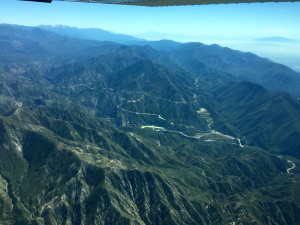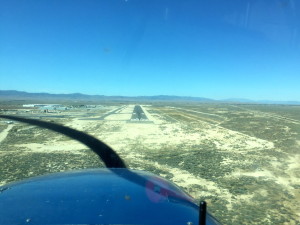First flight with a passenger!
April 8th, 2016 at 10:25 pm (Flying)
I took my first passenger for a ride in a plane! Manuel picked KWJF (General William J. Fox Field) as our destination, which is near Lancaster. In the desert. On the other side of the mountains. I had never been there.
I did my flight planning and research, and I was all ready to go with my nav log and GPS flight plan. The flight there and back went well, but it featured several new challenges for me:
- My highest altitude yet – 8500′. I’ve flown higher, but never as the pilot. Because KEMT and KWJF aren’t that far apart in straight-line distance, this meant we spent most of the time climbing and then descending. In a long climb, you have to think about “cruise climb” (lowering the nose to increase air cooling of the engine). In a long descent, you have to think about power and mixture settings to avoid fouling the spark plugs.
- Picking altitudes was challenging. In addition to clearing terrain, I needed to follow VFR conventions. This flight zig-zagged northwest, northeast, northwest, creating three different regimes (west trajectories use even thousands + 500′; east trajectories use odd thousands + 500′).
- As always for a new destination, I had to visually locate the airport :) Luckily KWJF is not too challenging to spot, unlike KEMT which is buried inside urbanity!
Cruising over the mountains yields some delightful views (photos taken by Manuel, not me :) ).

We approached KWJF from the south. Runway 24 has a right pattern by default (north side), but the tower kindly directed me to a left downwind approach from the south (instead of crossing over midfield). I still struggle with figuring out how to pace my approaches. I’ve been instructed to be at pattern altitude well before I enter the pattern, and I’ve read in several places that descending into the pattern is very dangerous (you could descend into another plane, since you can’t see below and they can’t see above). So I was at pattern altitude before entering downwind. But pattern altitude can feel rather low, especially at KWJF where it is only 800′ AGL! (More typical is 1000′.)

Final approach to runway 24 at KWJF.
On the return to KEMT, I got an instruction that was new to me: “maintain maximum forward speed.” I understood that the tower was trying to increase spacing between me and the plane behind me. But the importance of a controlled, stabilized approach has been drilled in to me, and I was already doing my usual process of gradually adding flaps and decreasing speed. (The plane is certainly capable of flying faster, but it won’t stop flying (i.e., land) until you get it going slow enough.) I acknowledged and continued, adding a tiny bit of speed. Maybe I should have said “unable” or “I am already going max speed”. Happily, I landed just fine and got off the runway before the other airplane needed it.
Back on land, I found this discussion of how to interpret “maintain best forward airspeed”. This procedure would have me flying > 100 mph until just 1 mile from the runway (!!), then slowing down and deploying flaps. Normal is 80 mph approaching, then slowing to 70 mph on final approach. I’ve landed at 80 mph (to practice a no-flap landing), but I wouldn’t do it by choice. I definitely would need to practice any kind of faster approach to get comfortable with it, and (as noted in the article), it would likely require more landing distance (runway). It’s useful right now, however, just to have the increased understanding of what ATC is asking for with that particular phrase.
I’m looking forward to more exploratory flights and more learning opportunities!
loretta jacobs said,
April 11, 2016 at 11:32 am
Please put me in your loop. So Proud of You…Deareast Kiri! Your GodmotherLJ